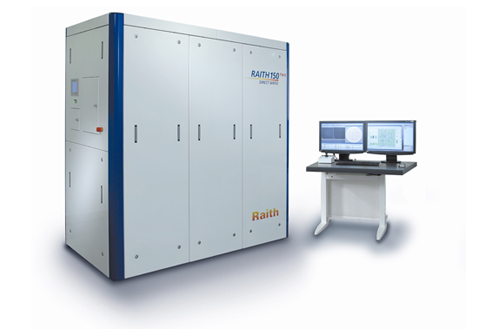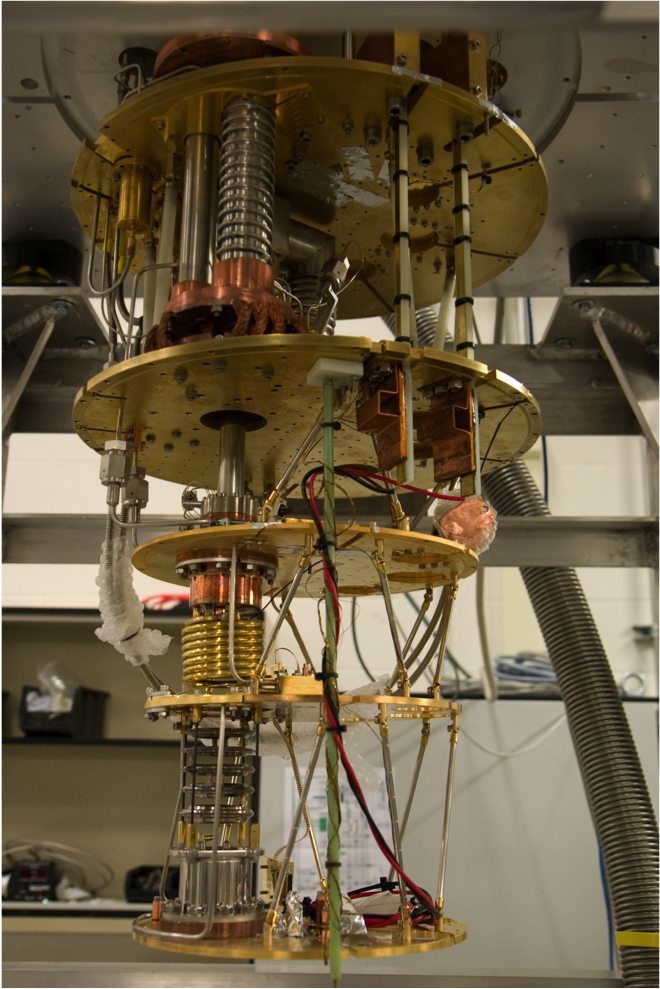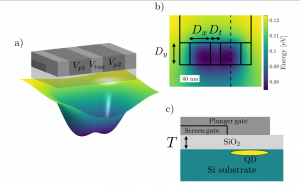- Solid-state implementations for quantum information processing (QIP)
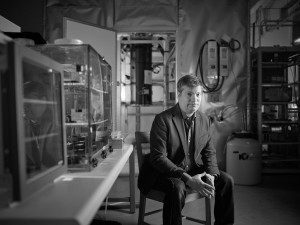
- Single-electron devices for spin-based QIP
- Quantum nano-electronics, quantum transport
- Methods of coherent control
Laboratory equipment and facilities
- State-of-the-art “dry” dilution refrigerator (Oxford Triton)
- Cooling power: 250 μW at 100 mK
- 8 T superconducting magnet
- Optical access
- Janis 1.5 K wet He cryostat and magnet system for device testing
- 4K and 77K device testing
- Room temperature electronic probe station
- Quantum Nanofab clean room facility
- JEOL and Raith electron beam lithography systems, SEM
- e-beam evaporators (metal deposition), reactive ion etching, photolithography, etc.
 A student using the probe station to perform a test of nanowire conductance. |
Insert of the Oxford VeriCold DR200 dilution refrigerator system. The bottom plate holds the He3-He4 mixing chamber and reaches base temperature. Sequentially, the upper plates are the 80 mK plate, the still plate, the 4 K plate, and the 70 K plate.
|
Quantum dots and spin qubits
 A quantum dot is an electrostatic potential well that confines a small number of electrons (as few as one) to a region tens of nanometers in scale. We would like to use the spin of a single electron (spin-1/2) as a quantum bit (qubit), and to arrange these qubits together scalably to form building blocks for large-scale quantum information processors.
A quantum dot is an electrostatic potential well that confines a small number of electrons (as few as one) to a region tens of nanometers in scale. We would like to use the spin of a single electron (spin-1/2) as a quantum bit (qubit), and to arrange these qubits together scalably to form building blocks for large-scale quantum information processors.
We have studied quantum dots formed in nanowires, carbon nanotubes, and two-dimensional electron gases in GaAs and Silicon. Our current focus is on Silicon metal-oxide-semiconductor (MOS) devices based on the potential for qubits with long coherence times in isotopically purified silicon and the potential for large large scale integration via commercial CMOS technologies. Our work spans theory/simulation and experiment, and is principally motivated by our published proposal for a scalable quantum processor based on a node/network approach.
Quantum devices in dopant-free GaAs
The use of undoped GaAs heterostructures allows ambipolar devices where the carrier type  (electrons or holes) is solely determined by the polarity of the top-gate voltage. This is not possible in modulation-doped sample, and allows for ambipolar devices with both N-type and P-type elements.
(electrons or holes) is solely determined by the polarity of the top-gate voltage. This is not possible in modulation-doped sample, and allows for ambipolar devices with both N-type and P-type elements.
We are interested in a class of devices known as a single-electron pumps. At low temperatures, these devices produce quantized current plateaus at I = nef, where e is the electron charge, f is the radio frequency (RF) of an ac signal applied to a local gate , and n is the number of electrons pumped from source to drain during each RF cycle. These 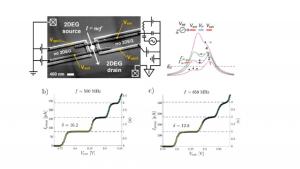 pumps do not require an applied source-drain bias, operate at high frequencies (~1 GHz), and are distinct from adiabatic turnstile pumps, which require a finite source-drain bias and a minimum of two RF gates to operate. Following the 2019 re-definition of the ampere in the International System of Units (SI), non-adiabatic single electron pumps have emerged as candidates to serve as primary standards for accurately measuring a ~1 nA current. During every RF cycle, an electron is “scooped” from the source reservoir and ejected into the drain reservoir. Note only one gate is operated at high frequencies. By tuning the barrier gates, the number n of pumped electrons can be precisely controlled, producing the current I = nef. The ability to eject individual electrons controllably is an important element of future quantum devices, such as an on-demand quantum light source or devices that exploit electron optics.
pumps do not require an applied source-drain bias, operate at high frequencies (~1 GHz), and are distinct from adiabatic turnstile pumps, which require a finite source-drain bias and a minimum of two RF gates to operate. Following the 2019 re-definition of the ampere in the International System of Units (SI), non-adiabatic single electron pumps have emerged as candidates to serve as primary standards for accurately measuring a ~1 nA current. During every RF cycle, an electron is “scooped” from the source reservoir and ejected into the drain reservoir. Note only one gate is operated at high frequencies. By tuning the barrier gates, the number n of pumped electrons can be precisely controlled, producing the current I = nef. The ability to eject individual electrons controllably is an important element of future quantum devices, such as an on-demand quantum light source or devices that exploit electron optics.
Additional research topics include:
- The development of topological qubits in InAs and InSb heterostructures, a joint project with Prof. Zbig Wasilewski’s molecular beam epitaxy group.
- Design and characterization of cryo-CMOS circuits to enable the scalable control and readout for spin-based quantum processors, in collaboration with Prof. Lan Wei (ECE).
- Transport studies of bi-layer graphene quantum devices, in collaboration with the group of Prof. Chandni U (IISc Bangalore, India).
View several research posters in our Research Gallery.
Interested in a Masters or PhD project? Highly motivated students are currently being sought. Group projects involve:
Students will gain both hands-on and theoretical experience across Physics, Chemistry, Materials Science and Electrical Engineering. Firm theoretical grounding (especially quantum mechanics), strong experimental aptitude and creativity are key qualities. Undergraduate 4th year projects Projects related to our research on quantum information and its implementations are available for CHEM 494 and PHYS 437 Contact: baugh [at] iqc.ca |

